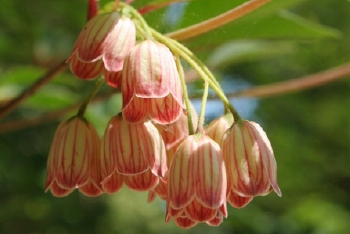Tree of the month: Enkianthus campanulatus
This charming shrub from Japan is our pick for Tree of the Month this May.
May is the best time to view the intricate bell-shaped flowers which open en masse in an enchanting spectacle.

The colour of these delicate flowers can vary, with descriptions ranging from white to a vivid raspberry-red, as can be viewed on specimens across the collection. Much of this variation is down to the striking, richly coloured venation which grows stronger towards the tip of the corolla (the collective name for the petals). Even as flowering finishes up, this shrub continues to dazzle, as petals fall and carpet the ground.
E. campanulatus is deciduous and can reach heights of 2-5m, although cultivated specimens have been recorded growing to 10m. The leaves are often condensed together at the tip of short branches, making them appear almost whorled. In autumn, these green-blue leaves ignite, turning fiery shades of reds, yellows and oranges. This show-stopping colour, along with the floral spring display, makes this a prized and much-loved plant here at Westonbirt and beyond.
This beautiful species is endemic to Japan and can be found on mountain slopes. It was introduced to cultivation the UK in 1880 by English botanist Charles Maries (1851–1902), for Messrs. Veitch of the famous Veitch Nurseries.

The scientific name is entirely inspired by the shape of the flowers. Enkianthus was named by the Portuguese Jesuit missionary and naturalist João de Louriero in 1790. It was derived from the Greek words enkyos which means pregnant and anthos- the word for flower. The specific epithet campanulatus references their bell-like shape.
All but two of our specimens are found in the Old Arboretum, along Main Drive and Circular Drive, this is because it flourishes in the patches of acidic soil found there. Look out for the white flowered form, Enkianthus campanulatus f. albiflorus on Willesley Drive in Silk Wood, near the junction with Palmer Ride.
